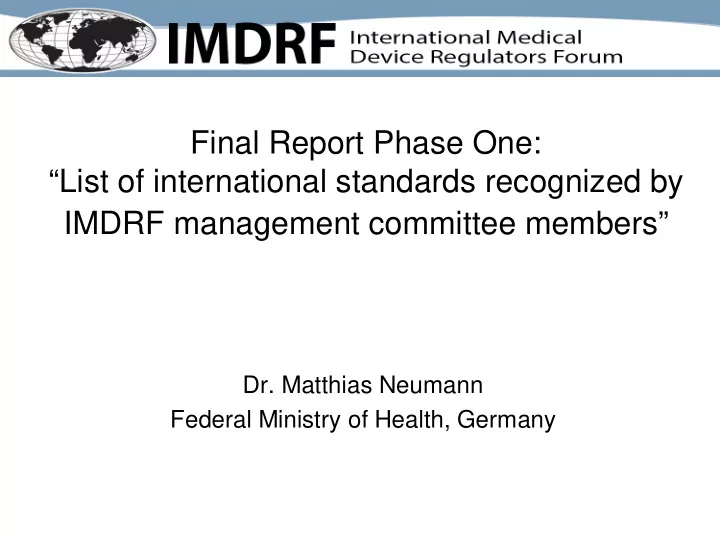

Final Report Phase One: “List of international standards recognized by IMDRF management committee members” Dr. Matthias Neumann Federal Ministry of Health, Germany
Mandate 2 Steps 1. Gathering information and creating a list of standards used for medical devices regulatory purposes that are recognized by IMDRF Management Committee members 2. Development of a procedure to continuously enhance the established list 2
Background The GHTF regulatory model is based on the principle that the regulation defines the essential principles for safe and effective medical devices. GHTF/SG1/N044:2008: Role of Standards in the Assessment of Medical Devices International Standards should specify (interpret) in detail how regulatory compliance (e.g. with the essential principles) for medical devices (processes or manufacturers) could be achieved . 3
Initiated Actions 1. Request for the nomination of national experts 2. Circulation of a list of 1102 valid international standards on Medical Devices (ISO/IEC) to USA, Canada, Australia, Japan, Brasil, China, Russia and the EU-Commission 3. Indication of the level of recognition of these standards (Y- fully recognized, N-not recognized, P-partially recognized or mandatory) by the nominated national experts 4. Compilation and assessment of the provided answers 4
Results • All 8 IMDRF members provided input to the project • a list with a clear indication of fully or partially recognized/mandatory standards was provided by 8 of the 8 regions/countries • The number of fully recognized standards (out of 1102 standards) varies between 261 and 44 • The number of partially and fully recognized standards varies between more than 390 and 44 • Three regions are using mandatory standards 5
Number of recognized/mandatory standards in IMDRF jurisdictions 0 0 0 32 0 0 9 134 3 0 0 0 0 105 77 26 261 237 222 0 180 119 102 95 0 0 0 44 0 0 0 USA EU Australia Canada Japan Brasil China Russia * 6 fully rec. partially rec. mandatory partially man.
• There are 2 standards which are recognized/mandatory by 7 of the 8 regions Document reference Publication Title ISO 14630 2008-01 Non-active surgical implants_- General requirements ISO 14971 2007-03 Medical devices_- Application of risk management to medical devices 7
There are 17 standards which are recognized/mandatory by 6 of the 8 regions Publication Title Document/reference IEC 62304 2006-05 Medical device software_- Software life cycle processes IEC 60601-2-20 2009-02 Medical electrical equipment_- Part_2-20: Particular requirements for the basic safety and essential performance of infant transport incubators IEC 60601-2-27 2011-03 Medical electrical equipment_- Part_2-27: Particular requirements for the basic safety and essential performance of electrocardiographic monitoring equipment IEC 60601-2-29 2008-06 Medical electrical equipment_- Part_2-29: Particular requirements for the basic safety and essential performance of radiotherapy simulators IEC 60601-2-39 2007-11 Medical electrical equipment_- Part_2-39: Particular requirements for basic safety and essential performance of peritoneal dialysis equipment IEC 60601-2-44 2009-02 Medical electrical equipment_- Part_2-44: Particular requirements for the basic safety and essential performance of X-ray equipment for computed tomography ISO 10993-1 2009-10 Biological evaluation of medical devices_- Part_1: Evaluation and testing within a risk management process ISO 10993-3 2003-10 Biological evaluation of medical devices_- Part_3: Tests for genotoxicity, carcinogenicity and reproductive toxicity 8 ISO 10993-4 2002-10 Biological evaluation of medical devices_- Part_4: Selection of test for interactions with blood
There are 17 standards which are recognized/mandatory by 6 of the 8 regions Document /reference Publication Title ISO 10993-6 2007-04 Biological evaluation of medical devices_- Part_6: Tests for local effects after implantation ISO 10993-12 2007-11 Biological evaluation of medical devices_- Part_12: Sample preparation and reference materials ISO 10993-14 2001-11 Biological evaluation of medical devices_- Part_14: Identification and quantification of degradation products from ceramics ISO 10993-15 2000-12 Biological evaluation of medical devices_- Part_15: Identification and quantification of degradation products from metals and alloys ISO 10993-17 2002-12 Biological evaluation of medical devices_- Part_17: Establishment of allowable limits for leachable substances ISO 11137-1 2006-04 Sterilization of health care products_- Radiation_- Part_1: Requirements for development, validation and routine control of a sterilization process for medical devices ISO 14155 2011-02 Clinical investigation of medical devices for human subjects_- Good clinical practice ISO 17664 2004-03 Sterilization of medical devices_- Information to be provided by the manufacturer for the processing of resterilizable medical devices 9
Findings By trying to globally harmonise requirements on medical devices the concept of the use of recognized standards in the different IMDRF jurisdictions needs to be further developed. The concept of the use of recognized/mandatory standards is currently implemented in the different IMDRF jurisdictions in different ways. 1. Effective mechanisms to establish a non binding list of recognised standards 2. “Translation” of the standards into national legislation 3. Focusing on standards which are used by the regulators to perform tests 4. Inefficient and expensive mechanisms to give a standard the legal status of a recognised, harmonised or mandatory standard. 5. Concentration on horizontal standards and product specific standards used for the assessment of high risk devices. (Since the assessment if standards are in compliance with the essential principles and the regional/national regulation is too complex and resource binding). 10
Findings Obstacles with regards to a more efficient use of the concept of recognized standards: - limited resources (for the assessment, for the implementation into the nat. regulation, for contribution to international standardization projects) - limited influence of regulatory bodies on standardization projects 11
Next Steps: 1. Each IMDRF jurisdiction will regularly update the “List” before the IMDRF Management Committee meetings 2. Further reflection will be conducted on a possible NWIP for establishing the second phase of the project. 3. The outcome of this reflection process will be presented at the next Management Committee meeting in September 2014 12
Thank you IMDRF Project: “List of international standards recognized by IMDRF management committee members” Progress Report 13
Recommend
More recommend